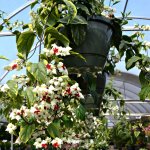Bleeding Heart Vine (Clerodendrum)
The bleeding heart vine, also known as Clerodendrum thomsoniae, is beloved for its clusters of heart-shaped white flowers that have a scarlet flower blooming at the tip. Once the red flower falls off, the white flowers lighten to a lavender or pink color that further prolongs the beauty it brings to your garden.
Bleeding heart vine (Clerodendrum) is an annual variety that blooms off and on throughout the year in milder climates, then typically dies in the winter if it’s not protected. It can grow in full sun and shade during the warm season.
Clerodendrum bleeding heart vines are ideal for adding vertical interest to gardens, fences, arbors, trellises, or hanging baskets. They can also be grown in containers for a stunning display on patios or balconies.
Did you know that Fairview Garden Center is actually one of the only places you can find Clerodendrum in the area? We have been propagating vines by hand for decades!




